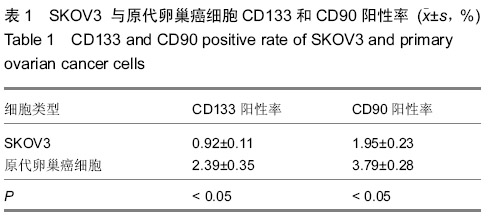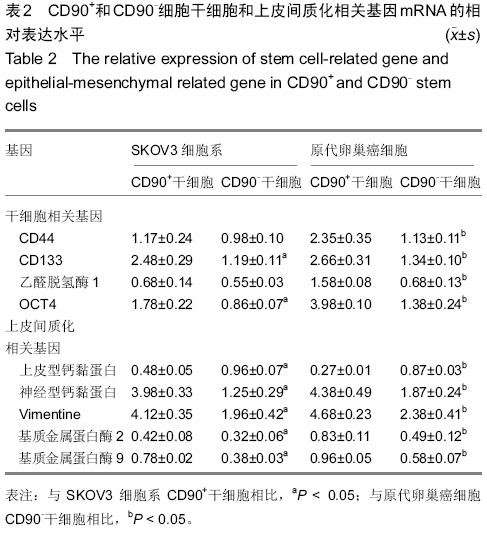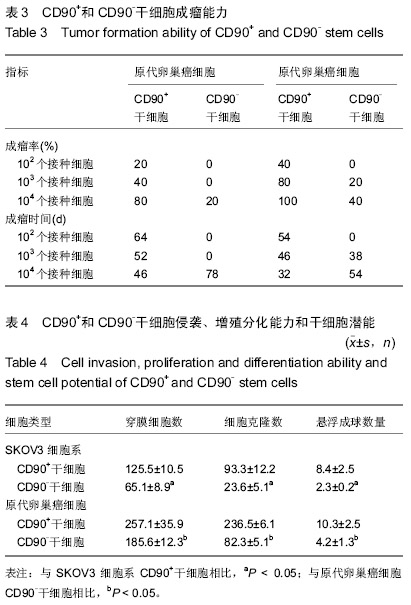| [1] 杨丽萍,侯俊德,段爱红,等.肿瘤干细胞标志物CD133和Ki67在卵巢癌中的表达及意义[J].临床和实验医学杂志,2015,14(5): 368-370.
[2] 杨丽萍,侯俊德,段爱红,等.肿瘤干细胞标志物CD133和Nestin在卵巢癌中的表达及意义[J].临床和实验医学杂志,2015,14(4): 301-304.
[3] 杨阳,林盛,黄佳妮,等.CD133+卵巢癌干细胞通过CXCL16/ CXCR6维持其侵袭迁移能力[J].第三军医大学学报,2015,37(8): 757-761.
[4] 张亚,何雅静,赵婷婷,等.肿瘤干细胞相关基因ABCB1、ABCG2在卵巢癌中的表达及其临床意义[J].中国妇幼保健,2014,29(10): 1599-1602.
[5] 翟颖仙,张丽红,周莉,等.肿瘤干细胞标记物LGR5和CD133在卵巢癌中的表达和意义[J].中国实验诊断学,2013,17(9):598-1601.
[6] 许君.WWOX基因转染对人卵巢癌干细胞上皮-间质转化影响机制的研究[J].临床医药文献电子杂志,2015,2(5):818-819.
[7] 孙大伟,李妍,李小晖,等.卵巢癌细胞系OVCAR-3中肿瘤干细胞样细胞的分离与鉴定[J].中国妇幼保健,2013,28(18):3001- 3003.
[8] 王爱春,王昀,顾依群,等.卵巢上皮性癌中CD24的表达及其临床病理意义[J].诊断病理学杂志,2013,20(7):387-389.
[9] Meirelles K, Benedict LA, Dombkowski D, et al. Human ovarian cancer stem/progenitor cells are stimulated by doxorubicin but inhibited by Mullerian inhibiting substance. Proc Natl Acad Sci U S A. 2012;109(7):2358-2363.
[10] Szotek PP, Pieretti-Vanmarcke R, Masiakos PT, et al. Ovarian cancer side population defines cells with stem cell-like characteristics and Mullerian Inhibiting Substance responsiveness. Proc Natl Acad Sci U S A. 2006;103(30): 11154-11159.
[11] Coffelt SB, Marini FC, Watson K, et al. The pro-inflammatory peptide LL-37 promotes ovarian tumor progression through recruitment of multipotent mesenchymal stromal cells. Proc Natl Acad Sci U S A. 2009;106(10):3806-3811.
[12] Bourguignon LY, Peyrollier K, Xia W, et al. Hyaluronan-CD44 interaction activates stem cell marker Nanog, Stat-3-mediated MDR1 gene expression, and ankyrin-regulated multidrug efflux in breast and ovarian tumor cells. J Biol Chem. 2008; 283(25):17635-17651.
[13] 刘丽,黎渊明,刘琴,等.干细胞移植联合顺铂化疗抑制卵巢癌细胞SKOV-3体外增殖、侵袭能力和体内肿瘤生长的研究[J].中国妇幼保健,2013,28(32):5354-5357.
[14] 鞠宝辉,黄宇婷,田菁,等.利用卵巢癌干细胞特异性基因表达谱进行针对性药物初步筛选[J].中华生物医学工程杂志,2013(4):293-299.
[15] 赵乐,纪新强,刘静,等.Nanog基因在卵巢癌和卵巢肿瘤干细胞中的表达及意义[J].现代生物医学进展,2012,12(14):2642-2646.
[16] Schreiber L, Raanan C, Amsterdam A. CD24 and Nanog identify stem cells signature of ovarian epithelium and cysts that may develop to ovarian cancer. Acta Histochem. 2014; 116(2):399-406.
[17] 桂玲,王静,祝爱珍,等.特异siRNA下调卵巢癌H08910细胞NAC-1基因表达并抑制生长[J].基础医学与临床,2012,32(10): 1221-1223.
[18] 闫洪超,于楠,仝建业.人卵巢癌HO8910细胞株中干细胞的筛选及生物学特性鉴定[J].江苏医药,2012,38(10):1152-1155.
[19] 吴秋华,王沂峰,郭蓉姣,等.卵巢癌OVCAR3细胞中CD133+细胞群的分离及其特性[J].中华妇产科杂志,2011,46(7):546-548.
[20] 赵雯红,程建新,史鹏飞,等.转染IL-12基因的人脐带间充质干细胞对卵巢癌细胞的体外增殖和对裸鼠体内移植瘤的抑制作用[J].南方医科大学学报,2011,31(5):903-907.
[21] 胡卫华,王净,窦骏,等.转染IL-21的CD34+脐血造血干细胞抗裸鼠卵巢癌作用研究[J].中华微生物学和免疫学杂志,2010,30(4): 326-331.
[22] 傅士龙,张国玲,李子庭.多周期大剂量化疗辅以外周血干细胞支持对难治性卵巢癌的治疗探索[J].肿瘤防治杂志,2002,9(3):363- 366.
[23] 钟艳平,孟泳圳,苏节,等.干细胞标志物在卵巢癌SKOV3细胞侧群细胞中的表达[J].中国肿瘤生物治疗杂志,2014,21(5):521- 525.
[24] Zhang S, Balch C, Chan MW, et al. Identification and characterization of ovarian cancer-initiating cells from primary human tumors. Cancer Res. 2008;68(11):4311-4320.
[25] Rege TA, Hagood JS. Thy-1 as a regulator of cell-cell and cell-matrix interactions in axon regeneration, apoptosis, adhesion, migration, cancer, and fibrosis. FASEB J. 2006; 20(8):1045-1054.
[26] 尹龙燕,李莉平,苏宁,等.卵巢癌干细胞对化疗药物耐药的机制探讨[J].现代生物医学进展,2014,14(33):6450-6453.
[27] Tang KH, Dai YD, Tong M, et al. A CD90(+) tumor-initiating cell population with an aggressive signature and metastatic capacity in esophageal cancer. Cancer Res. 2013;73(7): 2322-2332.
[28] Parry PV, Engh JA. CD90 is identified as a marker for cancer stem cells in high-grade gliomas using tissue microarrays. Neurosurgery. 2012;70(4):N23-24.
[29] Yamazaki H, Nishida H, Iwata S, et al. CD90 and CD110 correlate with cancer stem cell potentials in human T-acute lymphoblastic leukemia cells. Biochem Biophys Res Commun. 2009;383(2):172-177.
[30] Yang ZF, Ho DW, Ng MN, et al. Significance of CD90+ cancer stem cells in human liver cancer. Cancer Cell. 2008;13(2): 153-166.
[31] Ferrero JM, Weber B, Geay JF, et al. Second-line chemotherapy with pegylated liposomal doxorubicin and carboplatin is highly effective in patients with advanced ovarian cancer in late relapse: a GINECO phase II trial. Ann Oncol. 2007;18(2):263-268.
[32] Ferrero JM, Weber B, Geay JF, et al. Second-line chemotherapy with pegylated liposomal doxorubicin and carboplatin is highly effective in patients with advanced ovarian cancer in late relapse: a GINECO phase II trial. Ann Oncol. 2007;18(2):263-268.
[33] Power P, Stuart G, Oza A, et al. Efficacy of pegylated liposomal doxorubicin (PLD) plus carboplatin in ovarian cancer patients who recur within six to twelve months: a phase II study. Gynecol Oncol. 2009;114(3):410-414.
[34] Rose PG, Smrekar M, Haba P, et al. A phase I study of oral topotecan and pegylated liposomal doxorubicin (doxil) in platinum-resistant ovarian and peritoneal cancer. Am J Clin Oncol. 2008;31(5):476-480.
[35] Guastalla JP, Pujade-Lauraine E, Weber B, et al. Efficacy and safety of the paclitaxel and carboplatin combination in patients with previously treated advanced ovarian carcinoma. A multicenter GINECO (Group d'Investigateurs Nationaux pour l'Etude des Cancers Ovariens) phase II study. Ann Oncol. 1998;9(1):37-43.
[36] Weber B, Lortholary A, Mayer F, et al. Pegylated liposomal doxorubicin and carboplatin in late-relapsing ovarian cancer: a GINECO group phase II trial. Anticancer Res. 2009;29(10): 4195-4200.
[37] Pignata S, Scambia G, Pisano C, et al. A multicentre phase II study of carboplatin plus pegylated liposomal doxorubicin as first-line chemotherapy for patients with advanced or recurrent endometrial carcinoma: the END-1 study of the MITO (Multicentre Italian Trials in Ovarian Cancer and Gynecologic Malignancies) group. Br J Cancer. 2007;96(11): 1639-1643.
[38] Pujade-Lauraine E, Guastalla JP, Weber B, et al. Efficacy and safety of the combination paclitaxel/carboplatin in patients with previously treated advanced ovarian carcinoma: a multicenter French Groupe des Investigateurs Nationaux pour l'Etude des Cancers Ovariens phase II study. Semin Oncol. 1997;24(5 Suppl 15):S15-30-S15-35.
[39] Pujade-Lauraine E, Wagner U, Aavall-Lundqvist E, et al. Pegylated liposomal Doxorubicin and Carboplatin compared with Paclitaxel and Carboplatin for patients with platinum-sensitive ovarian cancer in late relapse. J Clin Oncol. 2010;28(20):3323-3329.
[40] Rapoport BL, Vorobiof DA, Slabber C, et al. Phase II study of pegylated liposomal doxorubicin and carboplatin in patients with platinum-sensitive and partially platinum-sensitive metastatic ovarian cancer. Int J Gynecol Cancer. 2009;19(6): 1137-1141.
[41] Pignata S, Scambia G, Savarese A, et al. Carboplatin and pegylated liposomal doxorubicin for advanced ovarian cancer: preliminary activity results of the MITO-2 phase III trial. Oncology. 2009;76(1):49-54.
[42] Kurtz JE, Kaminsky MC, Floquet A, et al. Ovarian cancer in elderly patients: carboplatin and pegylated liposomal doxorubicin versus carboplatin and paclitaxel in late relapse: a Gynecologic Cancer Intergroup (GCIG) CALYPSO sub-study. Ann Oncol. 2011;22(11):2417-2423.
[43] Pignata S, Scambia G, Savarese A, et al. Safety of a 3-weekly schedule of carboplatin plus pegylated liposomal doxorubicin as first line chemotherapy in patients with ovarian cancer: preliminary results of the MITO-2 randomized trial. BMC Cancer. 2006;6:202.
[44] Zheng H, Gao YN, Jiang GQ, et al. Combined pegylated liposomal doxorubicin and carboplatin in the treatment of recurrent epithelial ovarian cancer. Zhonghua Fu Chan Ke Za Zhi. 2008;43(11):839-842.
[45] 周晓水,杨宗元,张陶然,等.整合素β-1阳性卵巢癌细胞具干细胞样属性和间质属性分析[J].中国妇幼保健,2014,29(25):4155- 4159.
[46] 杨丽萍,侯俊德,段爱红,等.肿瘤干细胞标志物CD133和CD117在卵巢癌中的表达及意义[J].现代仪器与医疗,2014,20(5):8-10.
[47] 李笠.肿瘤干细胞标志物巢蛋白和CD133在卵巢癌中的表达及临床意义[J].中国医师进修杂志,2014,37(9):60-62.
|


